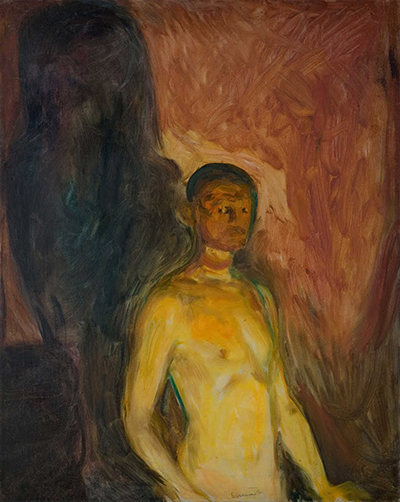Self Portrait in Hell is an oil painting on canvas created in the year 1903 by Edvard Munch - a Norwegian artist who combined Symbolism and Expressionism styles in his paintings to produce a truly unique approach.
Self Portrait in Hell depicts a photographic self-portrait of a naked man who happens to be Edvard Munch in the garden of his summer house. In the same year, Munch painted other self-portraits symbolizing his position as an artist and as a man which were a private hell. This fine piece of artwork was created at a time whereby Munch lived in Berlin and he was doing a collection of series called the Frieze of Life. Today it is housed in the Munch Museum in Oslo alongside the other masterpieces that he painted during his lifetime.
Similar to his works in this painting the background is painted with expressive brushstrokes that bring out an intense nervous atmosphere. There is no shortage of the use of color as the color-scale ranges from yellow, orange, brown, red to black and it expresses smoke and flames. In the foreground, there is a naked and unprotected figure of Edvard Munch while there is a great shadow to the left of the figure evoking the ideas of death. The painting expresses the obvious painfulness of the psychological situation though there is not a single way that it presents the artist as a helpless victim. All because Munch did this painting of himself while he was standing upright and self-assured like he was posing for an official portrait. Drawing his influence from Impressionists such as Claude Monet and Edouard Manet and later followed by post-impressionism artists such as Paul Gauguin and Paul Cezanne.
Other artworks by Edvard Munch include Kiss by The Window, Dance of Life and The Scream. The Scream was his most successful work in that it highlighted his career as an artist and it as among the most famous paintings in art history. Edvard Munch’s artworks created a great stir both to the public and art critics. This painting was criticized for promoting erotism and promoting his reflection of his sexual desires and anxieties. He favored the use of slurpy brush strokes makes the painting to look more stained. Also, the dark shadow symbolizes a grave and thus the elements of death. We learn a lot from his painting which is to first love and appreciate ourselves and most importantly there is no limit to expressing our emotions as he did.




